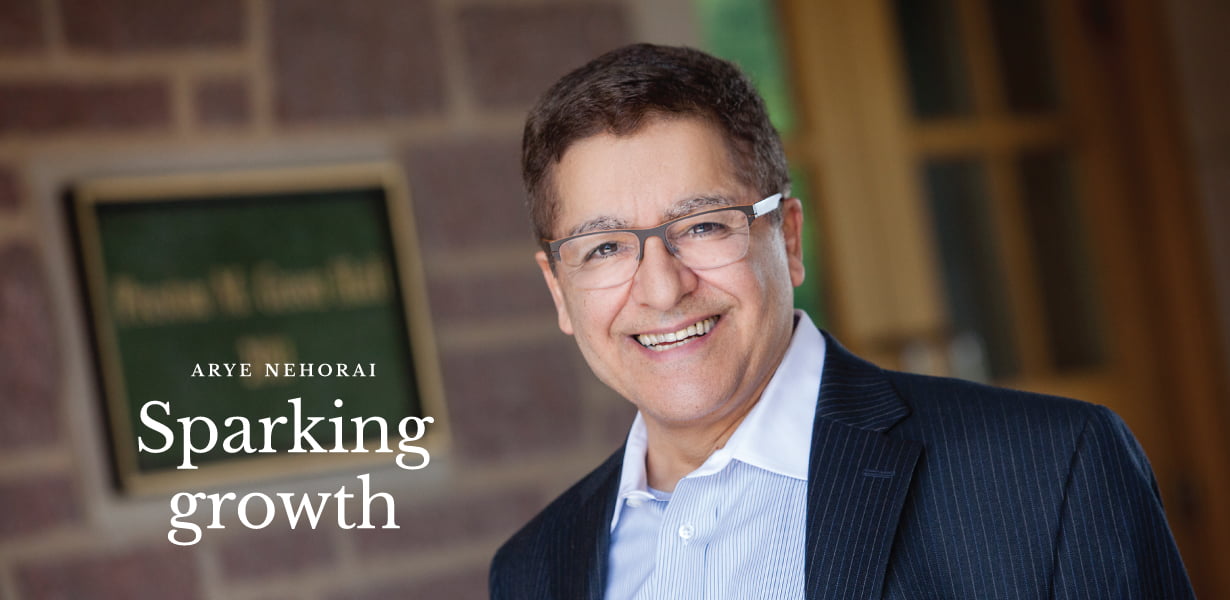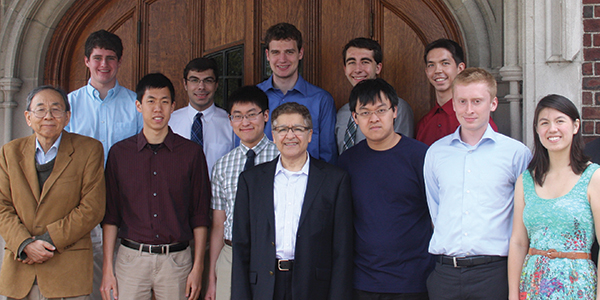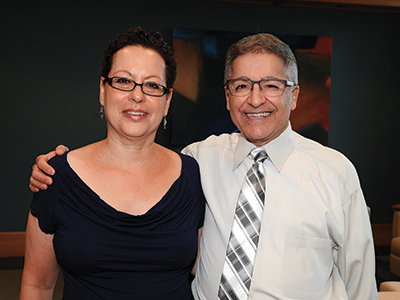Sparking growth
Arye Nehorai

When Arye Nehorai came to the School of Engineering & Applied Science as chair of the Department of Electrical & Systems Engineering in 2006, the department was at somewhat of a standstill: No new faculty had been hired in more than 15 years, and funded research and student enrollment were low.
But today, the department has nearly 600 total students taught by faculty active in research, many of whom were hired by Nehorai, who stepped down as chair June 30.
Hiring excellent faculty members is one thing Nehorai looks back on with pride. One of the first he hired was Lan Yang, now the Edwin H. & Florence G. Skinner Professor, who has received international recognition for her work with advanced nano/micro photonic devices. He has since hired eight of the current 14 tenured/tenure-track faculty members and eight lecturers and has appointed two professors of practice.

"All of the faculty I've hired have come from top-ranked universities," Nehorai says. "It is important that they would work on exciting and important topics that would have long-term impacts, were multidisciplinary and offered collaborations in different areas."
Nehorai, the Eugene and Martha Lohman Professor of Electrical Engineering, also has made a personal effort to recruit students, from undergraduate to doctoral students. Between 2008-2012, the enrollment of undergraduate students more than tripled, with much of the growth attributed to students who transfer into the department from other disciplines. That led to the department having the largest number of awarded bachelor's and master's degrees in the school in spring 2015.
To reach his goal of recruiting more students, Nehorai went to the source for ideas.
"We listened to what the students wanted, and they wanted a more hands-on experience," he says. "I was fortunate to have faculty and the school help me make it happen."
"The impact Arye has had on the department cannot be overstated," says Aaron Bobick, dean of the School of Engineering & Applied Science and the James M. McKelvey Professor.
“His focus on research excellence in hiring faculty coupled with the goal of growing the undergraduate programs has established the department as a critical component of the school.”
"The strengths he developed, including photonics and neuro-systems modeling, provides a strong base upon which to build further excellence."
— Aaron Bobick
In addition, he created and coordinated a summer study abroad program, supported by a donation from alumnus Charlie Simmons, that gives students the opportunity to visit various university labs and startup companies in those countries.
Simmons, who earned a bachelor's degree in electrical engineering in 1970, and Nehorai became acquainted when Simmons was a member of the school's National Council.
"I expressed concern that the Engineering school didn't have the same opportunities to study abroad and learn about other cultures that were available to other schools," said Simmons, who is retired from Network Appliance Inc., where he was vice president of marketing and of corporate development. "Arye quickly agreed that this would be a good experience for his students, and with my funding and his hard work, established a summer program for interested students in Electrical & Systems Engineering to visit universities in Israel and Germany. The students were universally pleased with what they learned about the research and teaching in these countries as well as the different cultures they experienced."
Simmons has stayed in contact with Nehorai over the years and is a former member of the department's external advisory board.
"The new talent he has recruited is outstanding," he said. "He has worked hard to get input from alumni and has grown the department in a way that I, as an alum, am very proud of."
A native of Israel, Nehorai has stayed close to the growth of the tech industry in that country with frequent visits to his alma mater, the Technion-Israel Institute of Technology, where he earned both bachelor's and master's degrees in electrical engineering after serving the required three years in the Israeli Air Force during some turbulent years from 1969-72. He left Israel in 1979 to earn a doctorate from Stanford University.
Nehorai attributes his love for higher education to his parents.
“I was fortunate to grow up with parents who gave me a guide for the future,” he says. His mother encouraged his love for higher education and the pursuit of an academic career.
“My father was an entrepreneur — he started a foundry — and I was always impressed by how he did it,” he said. “Eventually I decided on an academic career, but somehow I feel like I combined both of them as a department chair.”
After working in industry for a year, Nehorai went to Yale University, where he was on the faculty for 10 years before moving to the University of Illinois at Chicago, where he spent 10 years as a professor, including serving as chair of the Electrical & Computer Engineering Division before joining WashU.

Perhaps Nehorai's most visible accomplishment during his tenure as chair is the Preston M. Green Hall, which was completed in 2011 and houses the department. When he was hired at WashU, he knew that a new building was in the planning stages and began working with Nancy Green, the widow of alumnus Preston M. Green, as well as Mike Altepeter, director of Engineering facilities planning & management, on the process of creating a building that would meet the department's needs.
Nehorai will be taking a sabbatical, during which he plans to conduct research in signal processing and imaging, which has wide-reaching applications in security, defense and health, as well as energy and environment. He develops mathematical models of various systems, such as biological and physical, and uses statistical signal processing, machine learning tools and imaging to study measurements of the systems.
Earlier this year, he and his team developed a realistic 3-D multiscale mathematical model of the electrophysiology of pregnant women's contractions as they begin from a single cell to the myometrium, or uterine tissue, into the uterus that may aid in predicting preterm birth. Nehorai is principal investigator of research funded by the Office of Naval Research to study signal processing and of a multi-university grant funded by the Air Force Office of Scientific Research investigating advanced machine learning for radar systems. In addition, he is collaborating with faculty from the Sam Fox School of Design & Visual Arts to develop smart grids, smart homes and smart cities and to evaluate the benefits of using vacant land in shrinking cities.
Nehorai leaves the department leadership while it's still growing. Following his initiative, plans are underway for a new program in financial engineering, in partnership with the Olin Business School, that Nehorai says will create more interest in the department and searches for new faculty.
Back to Engineering Momentum